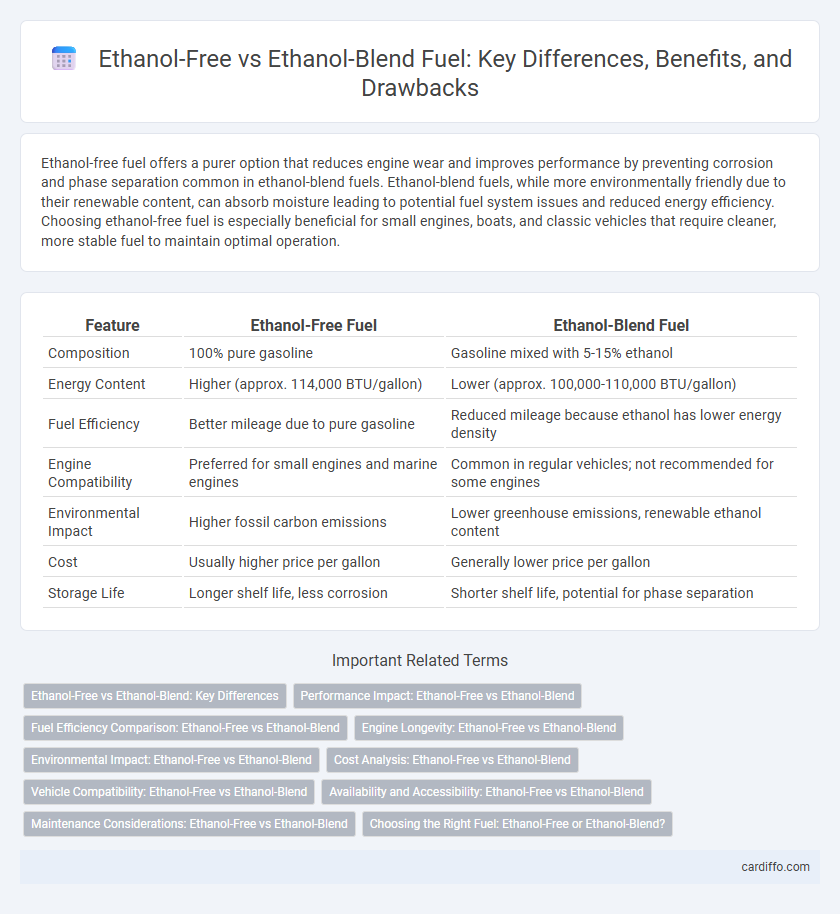Ethanol-free fuel offers a purer option that reduces engine wear and improves performance by preventing corrosion and phase separation common in ethanol-blend fuels. Ethanol-blend fuels, while more environmentally friendly due to their renewable content, can absorb moisture leading to potential fuel system issues and reduced energy efficiency. Choosing ethanol-free fuel is especially beneficial for small engines, boats, and classic vehicles that require cleaner, more stable fuel to maintain optimal operation.
Table of Comparison
| Feature | Ethanol-Free Fuel | Ethanol-Blend Fuel |
|---|---|---|
| Composition | 100% pure gasoline | Gasoline mixed with 5-15% ethanol |
| Energy Content | Higher (approx. 114,000 BTU/gallon) | Lower (approx. 100,000-110,000 BTU/gallon) |
| Fuel Efficiency | Better mileage due to pure gasoline | Reduced mileage because ethanol has lower energy density |
| Engine Compatibility | Preferred for small engines and marine engines | Common in regular vehicles; not recommended for some engines |
| Environmental Impact | Higher fossil carbon emissions | Lower greenhouse emissions, renewable ethanol content |
| Cost | Usually higher price per gallon | Generally lower price per gallon |
| Storage Life | Longer shelf life, less corrosion | Shorter shelf life, potential for phase separation |
Ethanol-Free vs Ethanol-Blend: Key Differences
Ethanol-free fuel contains 100% pure gasoline, offering higher energy content and better engine performance, particularly in small engines and older vehicles. Ethanol-blend fuel, commonly E10 or E15, mixes gasoline with 10-15% ethanol, reducing greenhouse gas emissions but potentially causing corrosion and reduced fuel efficiency. Choosing between ethanol-free and ethanol-blend depends on vehicle compatibility, environmental considerations, and fuel economy priorities.
Performance Impact: Ethanol-Free vs Ethanol-Blend
Ethanol-free fuel typically offers higher energy content per gallon, resulting in improved engine performance and better fuel economy compared to ethanol-blend fuels. Ethanol-blend fuels, such as E10 or E15, contain a percentage of ethanol that can lower the overall energy density, potentially causing reduced horsepower and mileage. Engines designed specifically for ethanol blends may mitigate some performance losses, but ethanol-free gasoline generally provides more consistent combustion and power output.
Fuel Efficiency Comparison: Ethanol-Free vs Ethanol-Blend
Ethanol-free fuel generally offers higher energy content per gallon, resulting in improved fuel efficiency compared to ethanol-blend fuels, which contain up to 10-15% ethanol and typically provide lower miles per gallon (MPG). Vehicles using ethanol-free gasoline often experience better mileage due to ethanol's lower energy density that reduces overall fuel economy by approximately 3-5%. Research shows that switching from a 10% ethanol blend (E10) to ethanol-free fuel can increase fuel efficiency by up to 4%, making ethanol-free a preferred choice for maximizing distance per fuel volume.
Engine Longevity: Ethanol-Free vs Ethanol-Blend
Ethanol-free fuel extends engine longevity by reducing corrosion and preventing the buildup of drying agents that can damage fuel system components. Ethanol-blend fuels, typically containing up to 10-15% ethanol, absorb moisture and can cause phase separation, leading to rust and deterioration in older or less compatible engines. Choosing ethanol-free fuel minimizes wear on seals, gaskets, and metal parts, promoting longer engine life and reduced maintenance costs.
Environmental Impact: Ethanol-Free vs Ethanol-Blend
Ethanol-blend fuels generally reduce greenhouse gas emissions compared to ethanol-free gasoline by displacing fossil fuel consumption and lowering carbon monoxide output. However, ethanol production can contribute to land use changes and water resource depletion, raising concerns about its overall environmental sustainability. Ethanol-free fuels avoid these agricultural impacts but tend to have higher carbon emissions and lower biodegradability than ethanol-blended options.
Cost Analysis: Ethanol-Free vs Ethanol-Blend
Ethanol-free fuel typically costs more per gallon than ethanol-blend fuel due to lower supply and higher production expenses. However, ethanol-blend fuels often improve engine efficiency and reduce carbon emissions, potentially lowering long-term operational costs. Considering fuel prices, engine compatibility, and environmental impact is essential for an accurate cost analysis between ethanol-free and ethanol-blend options.
Vehicle Compatibility: Ethanol-Free vs Ethanol-Blend
Ethanol-free fuel offers greater compatibility with older vehicles and small engines, as it prevents corrosion and degradation of rubber or plastic components often damaged by ethanol blends. Ethanol-blend fuels, such as E10 or E15, are suitable for most modern vehicles designed to handle up to 15% ethanol but may cause issues in classic cars, boats, and motorcycles. Choosing the right fuel depends on the manufacturer's guidelines, ensuring optimal engine performance and longevity by matching fuel type with vehicle compatibility.
Availability and Accessibility: Ethanol-Free vs Ethanol-Blend
Ethanol-blend fuels are widely available at most gas stations, making them easily accessible for everyday use across urban and rural areas. Ethanol-free fuel is less common and typically found in specialty stations, marinas, or regions with specific regulations, limiting its accessibility for general consumers. The broader distribution network of ethanol blends ensures convenience, while ethanol-free options often require additional effort to locate.
Maintenance Considerations: Ethanol-Free vs Ethanol-Blend
Ethanol-free fuel reduces the risk of engine corrosion and fuel system clogging, promoting longer-lasting fuel injectors and carburetors compared to ethanol-blend fuels. Ethanol-blend fuels attract moisture, increasing the potential for phase separation, which can lead to oxidized fuel and damage fuel lines and tanks. Routine maintenance with ethanol-blend fuels requires frequent fuel system cleaning and the use of fuel stabilizers to prevent injector deposits and ensure optimal engine performance.
Choosing the Right Fuel: Ethanol-Free or Ethanol-Blend?
Ethanol-free fuel offers higher energy content per gallon, providing better fuel efficiency and reduced engine wear, making it ideal for small engines and classic cars. Ethanol-blend fuels, commonly containing up to 10% ethanol (E10), are more environmentally friendly due to lower carbon emissions and are widely available at lower costs. Selecting between ethanol-free and ethanol-blend fuels depends on vehicle type, performance requirements, and environmental considerations.
Ethanol-Free vs Ethanol-Blend Infographic

 cardiffo.com
cardiffo.com